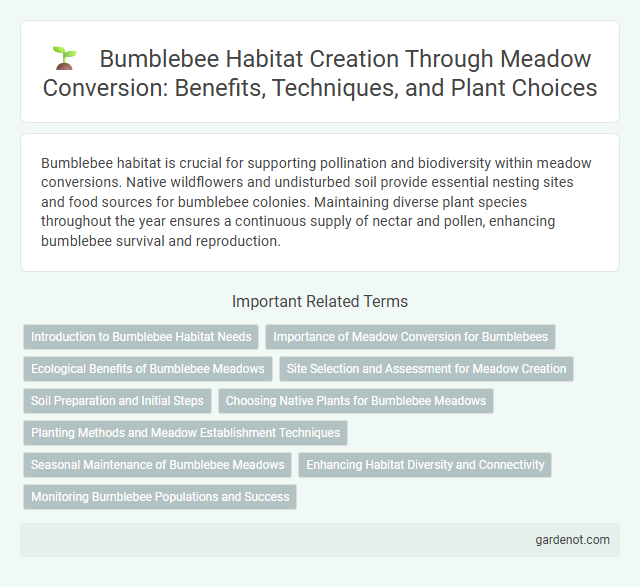Bumblebee habitat is crucial for supporting pollination and biodiversity within meadow conversions. Native wildflowers and undisturbed soil provide essential nesting sites and food sources for bumblebee colonies. Maintaining diverse plant species throughout the year ensures a continuous supply of nectar and pollen, enhancing bumblebee survival and reproduction.
Introduction to Bumblebee Habitat Needs
Bumblebee habitat requires diverse flowering plants to provide continuous nectar and pollen sources throughout the growing season. Nesting sites are essential, often found in undisturbed ground, tussock grass, or abandoned rodent burrows within meadows. Maintaining structural diversity in vegetation supports bumblebee foraging and reproduction, promoting healthy populations.
Importance of Meadow Conversion for Bumblebees
Meadow conversion plays a crucial role in preserving and enhancing bumblebee habitats by providing diverse floral resources that support their foraging needs throughout the seasons. Restoring native wildflowers and reducing pesticide use in converted meadows significantly boosts bumblebee population health and pollination efficiency. These habitat improvements contribute to the overall biodiversity and resilience of ecosystems reliant on bumblebee pollination services.
Ecological Benefits of Bumblebee Meadows
Bumblebee meadows provide essential habitats that support diverse pollinator populations, enhancing local biodiversity and ecosystem resilience. These meadows supply abundant nectar and pollen sources, which contribute to the health and reproduction of bumblebee colonies. Establishing bumblebee-friendly meadows also promotes natural pest control and improves crop pollination, benefiting agricultural productivity.
Site Selection and Assessment for Meadow Creation
Choosing a site with diverse native flora and adequate sunlight is essential for successful bumblebee habitat creation during meadow conversion. Soil quality assessment, including pH and nutrient levels, ensures optimal plant growth that supports bumblebee foraging and nesting. Proximity to existing bumblebee populations increases colonization potential and enhances habitat connectivity.
Soil Preparation and Initial Steps
Effective soil preparation is crucial for creating a bumblebee-friendly meadow conversion by enhancing nectar and pollen availability. Loosening the soil encourages diverse wildflower growth, supporting bumblebee foraging and nesting needs. Initial steps include removing invasive species and ensuring well-drained soil conditions to promote healthy plant establishment.
Choosing Native Plants for Bumblebee Meadows
Selecting native plants such as purple coneflower, goldenrod, and wild bergamot supports bumblebee foraging by providing essential nectar and pollen throughout their active seasons. Native flowering species promote pollinator biodiversity and enhance habitat connectivity, crucial for sustaining bumblebee populations. Prioritizing region-specific plants ensures greater resilience and adaptability within meadow conversion projects targeting bumblebee conservation.
Planting Methods and Meadow Establishment Techniques
Planting methods for bumblebee habitat in meadow conversion emphasize diverse native flowering species with staggered bloom times to provide continuous forage. Techniques such as seed drilling, plug planting, and using nurse crops enhance seedling establishment and soil health. Proper site preparation, including soil scarification and weed suppression, improves germination rates and promotes a robust, sustainable meadow ecosystem that supports bumblebee populations.
Seasonal Maintenance of Bumblebee Meadows
Seasonal maintenance of bumblebee meadows involves strategic mowing and selective flower planting to enhance pollen and nectar availability across spring to late summer. Removing invasive species and limiting excessive grass growth promotes diverse floral resources critical for bumblebee foraging and nesting. Timely habitat management increases bumblebee population resilience and supports pollination ecosystem services.
Enhancing Habitat Diversity and Connectivity
Enhancing habitat diversity and connectivity is vital for supporting thriving bumblebee populations during meadow conversion projects. Incorporating a variety of native flowering plants with staggered bloom periods promotes continuous forage availability, while establishing habitat corridors facilitates safe movement and genetic exchange among bumblebee colonies. These strategies increase resilience against environmental stressors and contribute to sustainable ecosystem health.
Monitoring Bumblebee Populations and Success
Monitoring bumblebee populations in meadow conversion projects involves regular surveys to track species diversity, abundance, and nesting success. Implementing standardized protocols such as timed transect walks and bumblebee netting enhances data accuracy for assessing habitat quality. Long-term monitoring enables the evaluation of meadow restoration impact on bumblebee reproductive success and overall ecosystem health.
Bumblebee habitat Infographic

 gardenot.com
gardenot.com